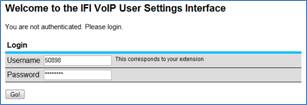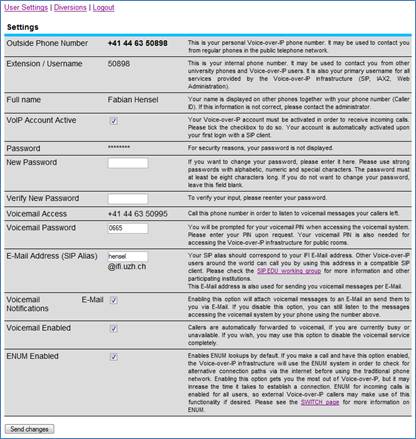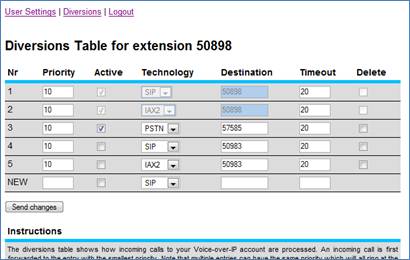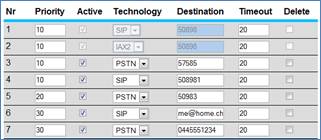Navigation auf uzh.ch
Navigation auf uzh.ch
Instead of having to change your user settings by using speed driven menu system, you can make changes to all relevant parameters by using a web based interface. In order to access the web based functions of the Voice-over-IP infrastructure, please point your web browser to the following address:
https://voip-internal.ifi.uzh.ch (Inside UZH)
https://voip-external.ifi.uzh.ch (VPN)
Please note, that you have to be connected to the university network directly or by VPN.
You will be presented with the following page:

Click “User Settings”.

Login with your primary username and password, as noted on your IFI Voice-over-IP Welcome e-mail / paper.

Immediately after you have logged in, you will be presented with the user settings dialog, shown above. Among other settings, you may change your primary password and Voicemail PIN. If you wish to change your password, please enter the password twice in the respective textboxes. Another important setting is the “VoIP Account Active” setting. Only if this setting is activated you can receive incoming calls. If you have ever used a SIP software client or telephone with the IFI Voice-over-IP infrastructure, your account is already activated.
The meaning of the individual settings is explained on the right side. Do not forget to click the “Send changes” button in order to make the settings take effect which happens immediately for all subsequent phone calls.
Clicking on the “Diversions” link at the top of the page, display the so called diversions table for your account. Your Voice-over-IP phone number is very different to a normal one. When someone dials your number, not only one but many different telephones (hardware or software) can ring at the same time or after each other. The Diversions Table allows you to configure exactly in which order your incoming calls are routed to your different telephones or Voice-over-IP clients. These “Destinations” must not necessarily be your own number. Call forwarding to secretaries and similar scenarios are possible as well.
Please consider the following explanation of the individual
configuration fields, as well as the example below (also featuring the
use of a 'secondary' username).

The above image shows a typical example of a diversions table that consists of five rules. Let us first go through the meaning of the different columns.
As you may have noticed, the top two entries cannot be deleted or changed. The reason for this is that it makes no sense to actually disable your Voice-over-IP account as a whole. If do not have any Voice-over-IP telephones registered with the Voice-over-IP infrastructure, these entries will simply be ignored. You may however change the priority of the entries to let your Siemens phone ring before your Voice-over-IP telephones.
Remember that in addition to your primary username you have nine secondary usernames available if you have more than one SIP or IAX2 phone that you wish to use with the Voice-over-IP infrastructure. These secondary usernames are not configured in the diversions table beforehand. In order to do so, enter the corresponding secondary username in the “Destination” field and select to appropriate “Technology”, either SIP or IAX2, depending on what type of phone you are using with the secondary username. Note that unlike the primary username, secondary usernames are not real phone numbers and can therefore only be used in the diversions table.
In order to better illustrate how the diversions table processing works, let us look at an example configuration:

When an incoming call is received with this configuration, it will be processed as follows: